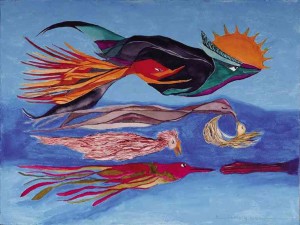Part 1
I can’t forget a story my friend Cora Alvina told me a long time ago about her lola, then 90 years old. She told the maid, “Paki-kunin mo nga ’yong kansonsilyong bughaw ni lolo.” The maid looked blankly at her.
“’Yong Jockey ni lolo na azul!” translated Cora. The maid was still stumped. Until a passing grandchild said, “’Yong blue na brip!” Immediately, the maid got it!
This reminded me of the disappearance of so many Tagalog words which were around in my childhood, many of which have already become hispanized and then anglicized. Today, practically all the kids I encounter in the malls are English-speaking. It seemed so “low class” if one’s kids spoke in Tagalog (!). Actually, a 2-year-old, reared quadrilingually in Tagalog, Dutch, Ilocano and Bisaya can easily absorb all four languages and even differentiate them from one
another.
Ask any bedimpled guy below 30 if he knows what “biloy” is. Chances are he won’t know it refers to the cute depression on his cheek. But maybe I speak only for Metro Manila, not the neighboring Tagalog provinces where possibly the language is still well-entrenched.
Discard the language long enough and, like my now-grown up grandchildren, you will have, in grade school, a lot of trouble with Araling Pilipino. Actually, it was a social studies subject written in profound Filipino, hated by pupil and tutoring parent alike. (Has it changed since?)
Often I wonder whether words or phrases like unli (calls or rice), quekquek, ukay-ukay (from halukay, to dig out from trunk, box or hole), tapsilog, ro-ro (roll on-roll off), “ok na po ba?” (Are you done?) will get into the Filipino dictionary.
Old dictionary
So many lost words, I thought I’d ukay them from my memory or some old dictionary.
Abayan was a common word for siping or “sleep beside” on the bed or the mat. As in, mother and child, sisters, or friends. It had no sexual connotation like siping has today. For instance, “Abayan mo muna ako kasi natatakot ako sa dilim.”

Lulan (verb) means “to board” as a truck, a jeep, a boat, a ship. “Lumulan na sila ’di pa man sumisikat ang araw.”
Agnas (verb) to me referred to the melting or disintegration to nothingness of a guttering candle. Or of life. “Naaagnas na ang buhay ng matanda nating lola.” Soon she will be gone, be nothing.
Quite a different thing is agnos (from Agnus Dei). It is a scapular or locket containing a printed holy picture, usually of a saint or a version of the Virgin Mary. One of the favorites was Nuestra Señora del Carmen, in a brown habit. So popular was it that the scapular became alternatively referred to as a calmin (Carmen).
The common and cheaper calmin was made of cloth, two rectangles, one for front and one for back, connected by a red ribbon. Almost all old women then wore calmin—to church, to the palengke, everywhere—as part of their daily native wear. Most Americanized younger mothers like mine did not wear agnos, although they, too, were unbendingly pious.
Sometimes the agnos is in the form of a locket on a chain in which is contained a relic. The religious relic, a chip of the cross of Christ or some such, led one to wondering whether that cross must have been as long as the circumference of the world, being still in supply after centuries.
It reminds me of National Artist Hernando R. Ocampo recounting that during the 1937 Eucharistic Congress in the Philippines, he would gather soil from the silong of their house in Maypajo, and put it in bottles to sell as “soil from the Holy Land.”
Another popular relic then was a sliver of bone from some saint or martyr which my rather irreligious father pooh-poohed as having come from a butcher’s stall. “Martyr” bones were also embedded in the crucifixes of millions of rosaries, but we believed in their authenticity because they were “holy.” So did the nuns of our school.
Double meanings
Gabok or alabok was the old term for alikabok.
Posporo is the newer term for the original Spanish-influenced casafuego (house of fire) or sacafuego (catch a fire), I forget which.
Dungo or torpe meant tanga or dumb, as was the later gunggong.
Some words have acquired double meanings. Like kulasisi (an innocent and decorative green and red caged bird) became the word for mistress or kept woman. They are not prostitutes or putachings, who during the Japanese time were called pampam.
Hawa means infection. For a long time it also meant “bad or shameful behavior.” Such as “hawa mo naman!”
Gamit simply meant “to use,” which later included sex.
Lutang or “floating” now also connotes being “up in the clouds,” not grounded. “Lahat ng bilin ko nakakalimutan ng katulong ko kasi lutang lagi.”
Apog or lime has acquired the additional meaning of “What gall!” as in, “Ang lakas ng apog mo!”
Sabit is to be implicated in somebody else’s wrong doing. Or “May sabit, bos” (it’s getting problematic.)
Bakla or bacla, according to linguists, never meant “homosexual,” it meant “doubt” or “hesitation,” and even Christ was at one time referred to in the bible as nababacla. But now if people can’t figure out what they are, they are bakla (but not tomboy).
Ladlad, to unfold or unfurl; make public. Now it is a homosexual term, “magladlad ng kapa” (or ng palda?) to mean a “coming out.” At one point Ladlad became a political party composed of gays founded by Danton Remoto.
When I was a child, Tagalistas referred to the sister of one’s mother or father as ale. It meant “aunt,” not just any woman on the street like it does today. But “aunt” also applied to any friends or acquaintances of one’s parents. The male “mamà” was also an honorific, like “ale.”
Next week na lang ang iba, ha?








































